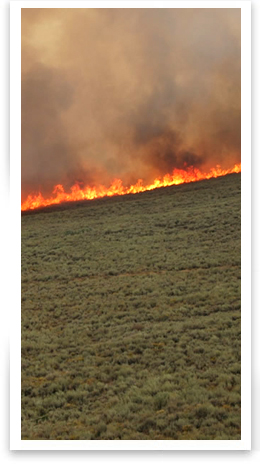Case studies - Fire management in the Amazon
Case Study 1: Human impacts on tropical rainforests
An outstanding example of interacting human impacts on tropical rainforests is provided by the paper by Nepstad et al. (2001) who examined feedbacks between Amazonian land management, regional climate and fire frequency. Rainforest clearing for grazing and slash and burn agriculture has introduced fire into the rainforest – agricultural land mosaic of much of the Amazonian basin. Planned road construction would further fragment this mosaic and opens up more forest areas for logging or agricultural activities. The implications of these policy decisions are discussed.
Outline the land-use change – climate – fire feedbacks that are operating in parts of the Amazonian basin. How can these feedbacks be broken?
![]()
Rainforest clearing and replacement with agro-forestry and grass-dominated pasture system has resulted in a wide spread increase in the occurrence of accidental fire. Land managers use fire to enhance grass and cattle productivity but have limited experience with fire nor finical resources to control it. Uncontrolled burning damages of crop and agro-forestry lands and producers are forced into reverting to grazing systems to cope with increased fire frequency. This ‘savannization’ further enhances the flammability of the landscape. Forest removal shifts land surface albedo (reflectivity) reducing evapotranspiration and the transfer of water vapour from the land to the atmosphere. This in turn reduces rainfall at a regional scale. Increased levels of smoke have a diluting effect on cloud formation, also contributing to a reduction in rainfall. Rainforest vegetation is sensitive to repeated fire and is unable to survive the shift fire frequency, again enhanced by the drying of the climate.
Nepstad et al. argue that improved fire management of producers is required to halt the widespread and uncontrolled fire.
In Module 4 we will look in more detail at reasons for this unsustainable use of rainforest natural resources – most of the causes are not related to a lack of ecological understanding, but are largely economic and geo-political. Solutions to improve forest management will also be examined.
Case Study 2: Rainforest management issues – impact of logging
While logging of rainforest may have ceased in Australia, it is still a major ecological service provided by tropical rainforests in many developing countries and an area of considerable and on-going controversy (see IUCN Proximate causes of forest land use change).
![]() Is sustainable logging possible in tropical forests?
Is sustainable logging possible in tropical forests?
Ecological knowledge of gap-phase regeneration properties of commercial timber species is vital to have any hope of sustainable logging regimes as harvest regimes can be matched to the natural disturbance levels and gap creation rates (Webb 1998). Knowledge of reproductive phenology of commercial species is also vital to enable harvesting to occur after of particular species have been pollinated or set and shed seeds.
![]() What is the nature of forest gaps created by logging – how
do they differ from natural gaps ? What differences are there in terms
of physical size, shape, orientation, proximity to mature seed trees,
soil conditions and potential damage to soil see banks?
What is the nature of forest gaps created by logging – how
do they differ from natural gaps ? What differences are there in terms
of physical size, shape, orientation, proximity to mature seed trees,
soil conditions and potential damage to soil see banks?
How fast do logged gaps recover when compared to natural gap-phase dynamics ?
- Examine the paper by Webb (1998). This paper addresses some of these questions in lowland Costa Rica rainforest that receives 4 m of rainfall. Logged and natural gaps were examined to assess the ecological impact of logging such a high diversity, high rainfall site.
This forest was logged using best-practice logging, the CELOS harvest system (see www.fao.org/DOCREP/005/AC805E/ac805e0n.htm) or reduced impact logging. This is a data rich paper but the Discussion provides interesting insights into the impacts on rainforest regeneration and diversity for so-called well managed logging practices that removed little canopy cover.
To what extent did logging practices in this forest compromise ecological services?
![]()
This paper suggests that well managed logging did not dramatically reduce regeneration potential of the forest, with a wide range of species still found in small, single tree log gaps (gaps caused by tree felling). After 6 years of regeneration a gap size effect was evident on floristic composition when compared with unlogged patches with pioneer or ruderal species dominating. However, there was still an abundance of late-phase species present suggesting regeneration would occur over time. The commercially important timber species Carpapa is a slow growing shade tolerant, mature phase species and in large gaps, there were limited seedlings surviving and regeneration would be a function of proximity to seed trees. Where this does not occur, seed regeneration of this important species would be at risk and seed augmentation of gaps would be required in a well managed forest operation.
Next - Module 4: Sustainable management of tropical ecosystems
Topics in this module
- Introduction
- Fundamentals of rainforest ecology
- Rainforest diversity, disturbance and gap-phase dynamics
- Australian rainforests - an overview
- Threats to rainforest ecosystems
- Case studies - Fire management in the Amazon
- Compulsory readings


